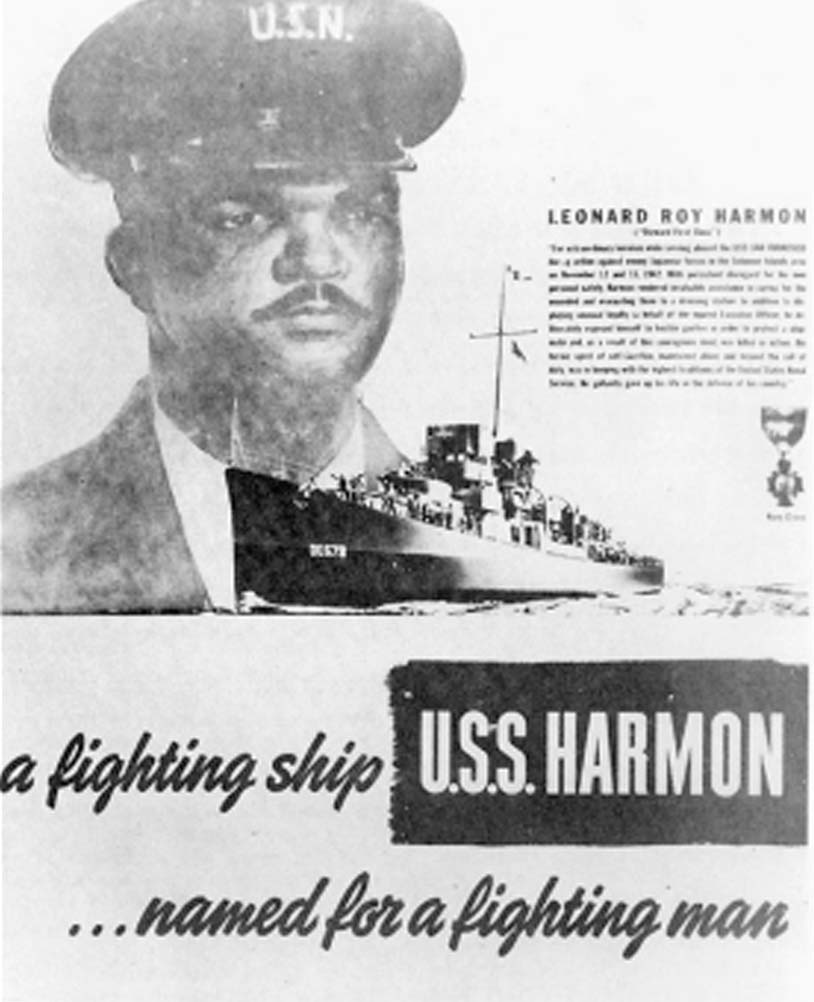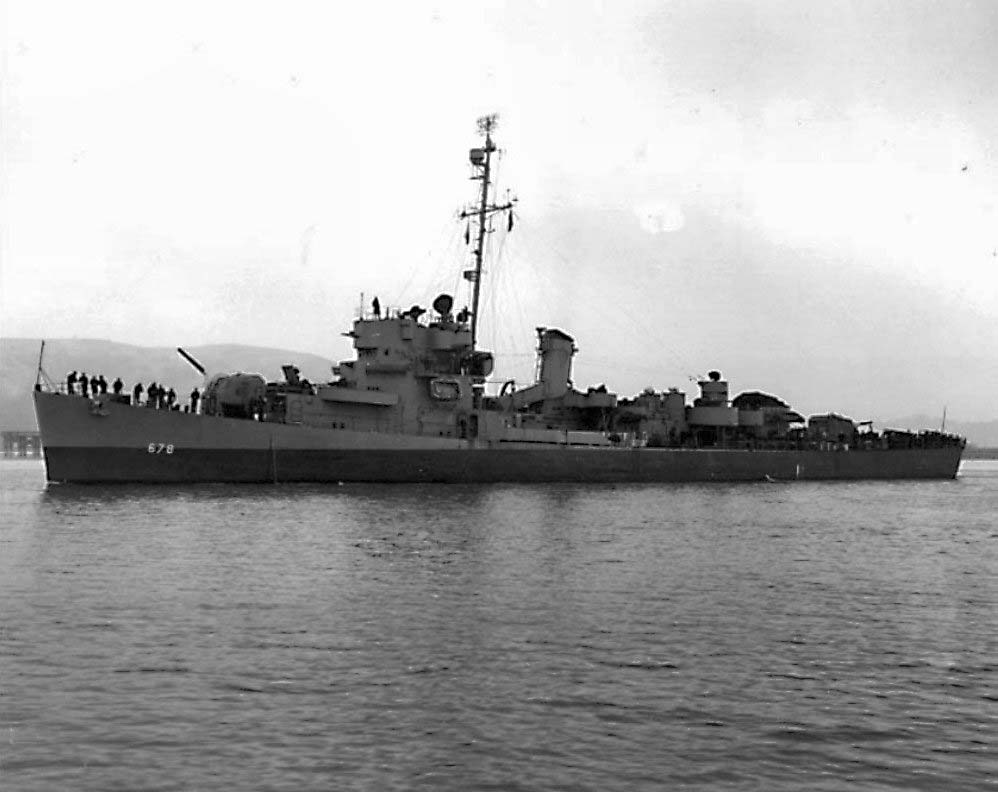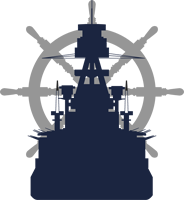Leonard R. Harmon: The First Black to Have a Navy Warship Named in His Honor
-by Heber A. Holbrook

Leonard R. Harmon
A Pacific Ship and Shore Reprint This article first appeared in
The 'Frisco' Newsletter, Number 32, April 1988.
Leonard Roy Harmon, "Len" to his close buddies on the "Frisco" was killed in action aboard the (CA-38) 1942 in the Battle of Guadalcanal. Leonard Harmon was a hero. A real bonafide authentic hero. A hero unsurpassed in courage and selflessness by any other hero of our wars. For his action in the battle in which he lost his life he was awarded the Navy Cross. have a warship of the United States Navy named in his honor. The USS Harmon (DE-678) was christened by Leonard's mother, Juanita Harmon Carroll and launched on July 25, 1943, at the height of the war, at the Galveston, Texas ship works, in the state in which Harmon was born. Born in the little town of Cuero, Texas, some fifty miles from Matagorda Bay on the Gulf Coast, Leonard, like may another young Texas farm boy of the 1930s, no doubt cast his eyes seaward in search of a future more meaningful than the dawn to dusk labor in the cotton fields and the marginal existence of a black share-cropper's son.He was twenty-two years old when he caught a bus to Houston and joined the Navy in June 1939 as a mess attendant recruit, the only rating open to the Negro race in the American Navy of that day in a country still rigidly racially segregated. Leonard was sent to Mess Attendant's School in Norfolk, Virginia, where he learned the work of his trade. It was not unlike the work of one of his uncles who was a Pullman car porter for the Southern Pacific Railroad. Aboard a Navy ship a mess attendant cleaned the officers' staterooms, made their beds, cooked their meals, and served as a personal butler for the senior officers.
All those chores Leonard Harmon learned how to do, anddid when he reported for duty in the heavy cruiser USS San Francisco (CA-38) in late 1939. But there was more. He also learned first-aid and how to be a stretcher bearer, and was assigned a Battle Station in one of the ship's "Battle Dressing Stations." It was in that capacity that I came to know Leonard Harmon, after I came aboard the San Francisco from the Naval Hospital, Pearl Harbor, a week after the Japanese attack of December 7, 1941. Aboard the "Frisco" the hospital corpsmen were frequently shifted around from one Battle Dressing Station to another, as their General Quarters assignment, so they would learn everything they needed to know about every part of the ship. In each Battle Dressing Station in addition to the regular medics there were also one or more mess attendants assigned as stretcher bearers and as first-aid men. I had on more than one occasion been assigned the same station as Leonard Harmon, and I remember him well. He was the kind of man who makes a lasting impression. He stood over six feet tall and carried a couple of hundred pounds, with big arms and shoulders that told you he would be nobody to have mad at you. He had a good disposition, a good mind, carried himself with a friendly dignity that made you feel comfortable to be around him. He was a much liked and respected hombre in .Officers Country. by both the brass and his fellow workers. By the time of the Battle of Guadalcanal he had been advanced to Mess Attendant First Class, which made him one of the senior mess attendants of the ship. He had a lot to say as to who did what and how in his line of work aboard the ship. One could say he had the rank, the muscle, and the no-nonsense friendliness so useful in keeping the uncomplicated Navy of those times running smoothly and without fuss.
At Guadalcanal on November 12, 1942, in early afternoona Japanese plane, afire from anti-aircraft fire from our force, crashed into the after superstructure of the San Francisco, killing 22 men and injuring as many more.
Leonard's battle station was in the Topside Battle Dressing Station, which was the aid station of first response to the crash. The ship's two doctors, the ship's dentist, the hospital corpsmen and the stretcher bearers, not to mention members of the ships crew, all of whom were trained in giving first aid, cared for the wounded on the scene, evacuated them to the Crew's Mess Hall (a secondary Battle Dressing Station) and the Sick Bay (the main Battle Dressing Station), for more definitive treatment. Leonard Harmon was a busy man that afternoon. Among the seriously burned by the exploding aircraft was the ship's Executive Officer, Commander Mark Crouter. Commander Crouter had his burns dressed in the crew's mess hall, after which he walked, with the assistance from an unknown hospital corpsman and a mess attendant, to his stateroom where he was put to bed and made comfortable. Although he was seriously injured, Commander Crouter was not among those evacuated to the transport President Jackson that same afternoon, he and Captain Cassin Young (and no doubt with the concurrence of the Senior Medical Officer, Edward Lowe) having decided that he should remain aboard. I was one of the corpsmen treating the wounded in the mess hall that afternoon (ordered there from my regular station as the pharmacist's mate assigned to the Forward Repair Party), and assisted in tending to the wounds of Mark Crouter and others, as one of the several medics there doing everything we could on that busy afternoon. Leonard Harmon could well have been the mess attendant who assisted the Executive Officer to his stateroom that afternoon. In any event, Harmon would be back on duty at his General Quarters station in the Topside Battle Dressing Station later that night, and a little after midnight, in the second hour of the early morning of November 13th, he died a hero's death. Leonard Harmon died in what naval historians call one of the fiercest battles in the history of surface warfare. The San Francisco was flagship of a cruiser and destroyer taskforce that engaged a force of Japanese battleships, cruisers and destroyers. With the sky lighted up with salvos being fired by both the American and the Japanese ships, Leonard Harmon and corpsman Lynford Bondsteel stood outside of an open (but darkened) hatchway watching the outgoing and incoming salvos as the action opened. From their vantage point they could watch the fireworks and at the same time be able to quickly go to any topside area that might take an incoming round. Just minutes after the first salvos got off from the Japanese ships, Harmon and Bondsteel stood transfixed in fascination as they watched a huge fiery red ball streaking in on a trajectory where clearly they must have simultaneously both realized it would hit just about where they were standing. Relative safety lay through the hatchway and down the ladder immediately inside. Lynford Bondsteel's response was quick, but did not match the swiftness of Leonard Harmon's. Leonard Harmon could have bounded through the hatchway and down the ladder to safety. Instead, he grabbed Bondsteel and hustled him through ahead of him. Bondsteel literally stumbled on the ladder steps as the shell hit. Harmon was half in, half out, of the hatchway. There he died, riddled with shrapnel. A dazed Bondsteel, with a torn and bleeding hand from shrapnel pieces, picked himself up, and in the wreckage and carnage that continued on as may more hits were taken by the flagship, was able to assist with caring for the ship's many casualties. He would forever marvel at the delicate balancing act of the fates which on that night of Friday the 13th had kept him alive, thanks to Leonard Harmon and his selfless act. After the .Bloody Battle of Guadalcanal., the ship returned to Espiritu Santo to off-load casualties, and on November 15 Lynford Bondsteel and I, and others, as battle casualties, were placed aboard the hospital ship USS Solace, and thence taken to the 142nd Army General Hospital in the Fijian Islands for treatment and further evacuation to the U.S. for treatment and return to duty. The account of Leonard Harmon's valor came to me first-hand from Bondsteel right after the battle, told to me as I remember it, and as related in my later history of the USS San Francisco in 1978. The USS Harmon (DE-678), named for Leonard RoyHarmon, received three battle stars for its service in the Pacific in World War II; and after it was recommissioned during the Korean War. In the 1950s it operated out of the Naval Sonar Base in San Diego, a unit of the same destroyer escort squadron as the DE upon which I served during the early 1950s. I never watched the Harmon come in to dock or anchor that I didn't reflect upon the circumstances that resulted in her having that name. Not long after Leonard Harmon's death, the Navy opened up the ratings so a black was no longer strictly confined to the servant and officers cook ratings found only in the wardroom; and doubtlessly Harmon's death, with many, many others, helped bring down the doors of service bias found in the pre-World War Two armed services. In 1975 the Naval Air Station, North Island, California, named the bachelor enlisted quarters Harmon Hall to honor his memory. More recently, in the town of his birth, Leonard Roy Harmon was recognized by the erection of an official historical marker in the Cuero Municipal Park, during the 123rd Birthday of the Emancipation Proclamation, held in Cuero, Texas in June of 1986.

U.S.S. HARMON (DE-678): Named in honor of Leonard R. Harmon, killed in action aboard the USS San Francisco in the Night Naval Battle of Guadalcanal 13 November 1942. Photo: National Archives # 80-G-45162
With thanks to Shipmate Gene Tarrant, a close friend of Leonard Harmon aboard the San Francisco, for his comments and for a copy of the Cuero, Texas Historical Committee's commemoration
